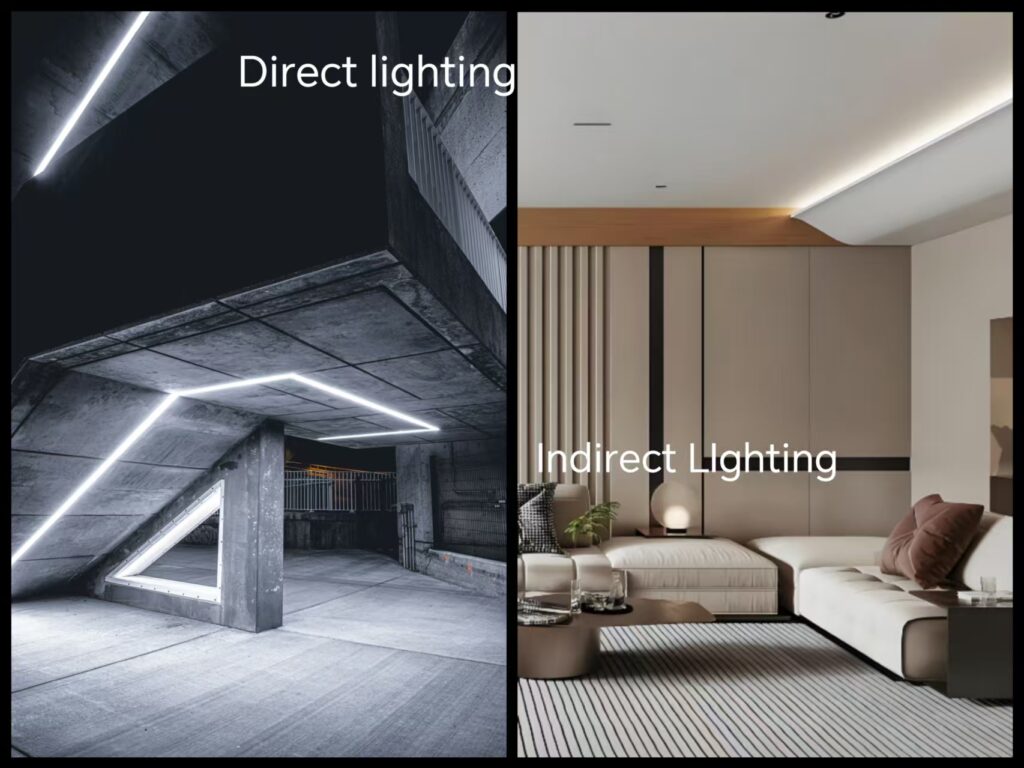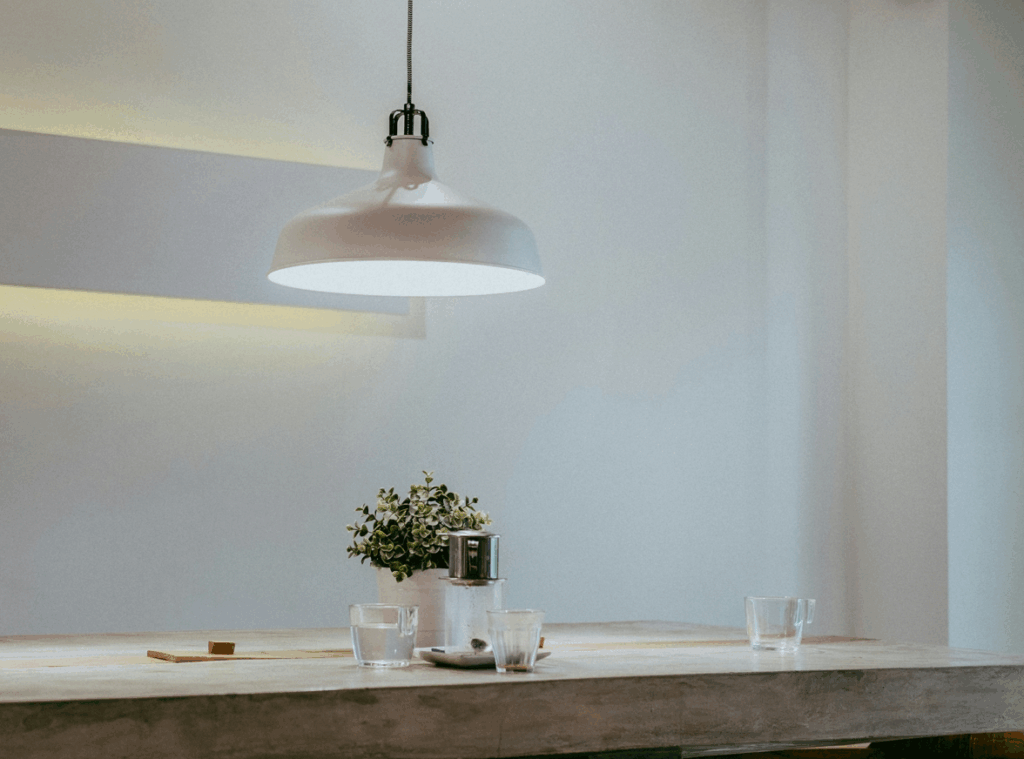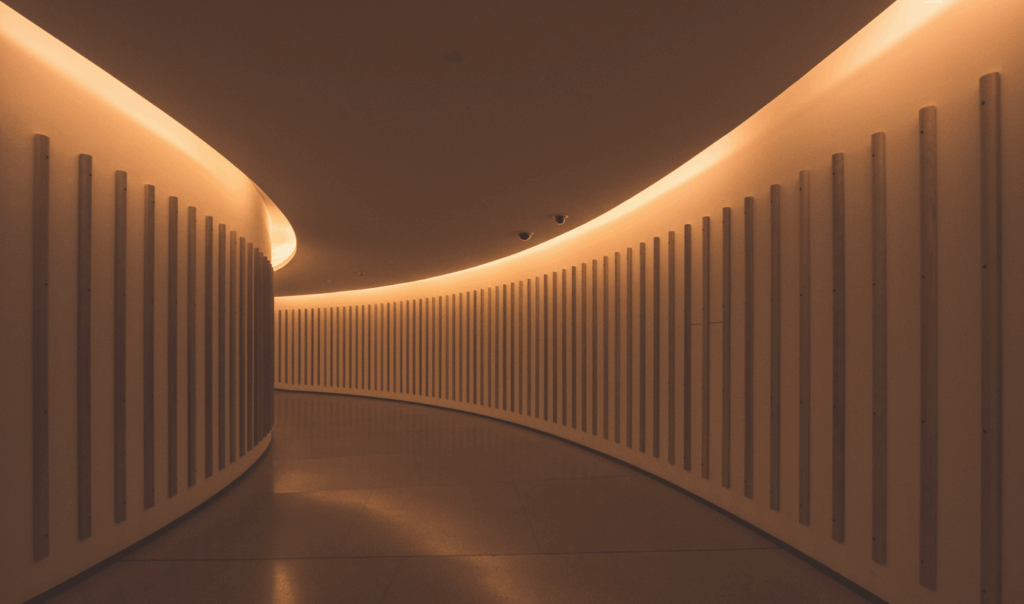Simple Definition
Simply put, direct lighting refers to light that shines directly onto objects, where the light source is typically visible to the naked eye. Its advantages include high brightness and strong practicality, while its disadvantages are a tendency to cause glare and weaker aesthetic appeal.
Indirect lighting achieves the effect of “light visible, but not the light source” through reflective surfaces (walls, ceilings, etc.). Commonly found in high-end commercial spaces, it utilizes concealed light sources like light strips to produce soft, glare-free illumination, creating a richly layered and comfortable lighting environment.

Direct Lighting
what is direct lighting?
Direct lighting refers to when over 90% of the light emitted from a fixture reaches the surface requiring illumination. High light utilization, bright and concentrated, producing strong light-dark contrasts and distinct shadows.

Technical Features
- Light efficiency utilization reaches the highest level among integrated lighting methods
- Work surface illuminance uniformity can be controlled within ±10% tolerance
- Applicable luminaire types include directional lighting devices such as downlights and spotlights
Direct lighting emphasizes focal points and creates a sense of prominence within a space. However, its single light direction creates stark contrasts between illuminated and shadowed areas, often resulting in glare. Beyond residential settings, it’s commonly used in large commercial spaces like factories or offices requiring high brightness levels. To mitigate glare, fixtures are typically fitted with grid-like or strip-shaped metal baffles.
Advantages and Disadvantages Comparison
| Avantages | High Efficiency & Energy Saving: Maximizes the utilization of luminous flux, providing brighter illumination on the target surface for the same power consumption. | Focuses Attention: Clearly defines spaces and strongly accentuates visual focal points and details. | Simple Structure: The design and manufacturing of many direct lighting fixtures are relatively straightforward and cost-effective. |
| Inconvénients | Prone to Glare: Light shining directly into the eyes can cause discomfort and visual fatigue. | Harsh Contrast: Can create strong brightness differences, leaving non-illuminated areas of a space too dark and potentially creating a oppressive atmosphere. | Hard Shadows: Can cast sharp and distracting shadows of hands or objects in work areas (e.g., kitchen counters, desks). |
Direct lighting fixtures
| Types | Caractéristiques | Scénarios d'application |
| Downlight | Recessed into the ceiling, all light projects downward, space-saving. | Bedroom, living room, bathroom perimeter for basic or ambient lighting. |
| Spotlight | Adjustable angle, emphasizes specific objects, creates strong shadows and focal points. | Accentuating paintings, sculptures, or creating layered light in shops and homes. |
| Pendant Light | Suspended from the ceiling with a cord or chain, strong decorative style, often with a single or multiple shades. | Dining table, kitchen island, living room (multi-head), or bedroom (single-head). |
| Ceiling Light | Mounts directly flush to the ceiling, simple installation, soft and uniform light, space-saving. | Living room, bedroom, corridor, kitchen, and other rooms where basic illumination is needed. |
| Track Light | Multiple adjustable lamp heads installed on a track, allowing flexible positioning and angle changes. | Living room, gallery, shop, bathroom for accent or flexible lighting. |
| Wall Light | Fixed to the wall, provides soft, indirect, or directional light, used as auxiliary lighting. | Corridor, bedside, balcony, mirror front for ambient or task lighting. |
| Floor Lamp | Portable, placed on the floor, ideal for local lighting to create atmosphere. | Beside a sofa or in a corner for reading or creating ambient light. |
Eclairage indirect
What is Indirect lighting?
Indirect lighting, also known as reflected lighting, refers to lighting where fixtures or light sources direct over 90% of their light toward ceilings, walls, or reflective surfaces. This creates soft, even ambient light through diffuse reflection. It avoids direct light entering the eyes, minimizing glare and harsh.

Technical Features of Indirect Lighting
- It utilizes a reflective light path, bouncing light off surfaces like ceilings or walls before it illuminates the space.
- It creates a large, uniform luminous surface that minimizes glare and harsh shadows.
- It offers high visual comfort by preventing direct light from reaching the eyes.
- It requires precise positioning and concealed fixtures to achieve the desired effect.
- It experiences higher light loss, often needing more powerful light sources for sufficient illumination.
- It often relies on integration with architectural elements or custom designs.
Advantages and disadvantages of indirect lighting
| Avantages | Comfortable & Glare-free: Soft, uniform light that is gentle on the eyes, greatly enhancing visual comfort. | Spaciousness: Illuminating ceilings and walls creates a visual effect of expanding the space and increasing height. | Ambiance Creation: Easily creates a calm, cozy, premium, and layered lighting atmosphere. |
| Inconvénients | Lower Energy Efficiency: Light loss occurs during reflection, requiring higher-power fixtures to achieve the same illuminance as direct lighting. | Higher Initial Cost: Often requires custom light troughs, special structures, or specific fixtures, increasing design and installation costs. | Insufficient for Tasks: Excellent as ambient light but unsuitable for providing focused, sufficient light for tasks like reading or detailed work. |
Common Indirect Lighting Fixtures and Their Applications
| Types | Caractéristiques | Scénarios d'application |
| Cove Light | LED strips or linear fixtures hidden in ceiling recesses, cornices, or shelves, washing walls/ceilings with soft, even light. | Living room, bedroom, restaurant, hotel lobby for creating a floating ceiling effect and defining space contours. |
| For WALL | A type of linear fixture installed close to the wall, specifically designed to emphasize the texture and verticality of the wall surface (e.g., brick, stone). | Accent wall, corridor, museum to highlight material texture and create dramatic visual effects. |
| Up-light | Floor-standing or wall-mounted fixtures that project all light upwards, such as torchiere lamps. | Corner of a room, beside a sofa, in commercial spaces to provide general ambient lighting and enhance ceiling illumination. |
| Indirect Pendant Light | Suspended fixtures with an upward-facing opening, casting light towards the ceiling. | Conference room, dining area, above a kitchen island for soft, non-glaring general illumination. |
| Shadow Gap Light | Ultra-narrow linear lights hidden in deliberate gaps or seams within walls, ceilings, or steps, creating a sleek, modern “light from nowhere” effect. | Modern minimalist interiors, stair steps, wall panels to define clean lines and architectural details. |
| Backlit Panel | A luminous surface, like a ceiling panel or wall panel, where the light source is hidden behind a diffuser, creating a uniform glow. | False ceiling, bathroom mirror backlighting, retail display to create a soft and modern visual effect. |
How to Quickly Distinguish and Choose?
How to Distinguish Between Direct and Indirect Lighting
Just remember the most fundamental visual difference:
Direct Lighting: You see the light, not the light source (fixture).
- You can directly see the light source or LED beads, with light shining directly into your eyes.
- Feeling: Bright, focused, potentially glaring.
- Examples: Desk lamps, spotlights, downlights.
Indirect Lighting: Light is visible, but the light source is not.
- You cannot see the light source. Light first reflects off surfaces like ceilings or walls before softly diffusing outward.
- Feels: Soft, even, comfortable, atmospheric.
- Examples: Ceiling light coves, light strips, floor lamps with upward-facing light.
How to Choose Between Direct & Indirect Lighting
Core Principle: In most sophisticated and comfortable spaces, the best practice is to combine both direct and indirect lighting to create a layered lighting scheme.
You can use the following flowchart as a quick guide to determine which type of lighting to prioritize for a specific need:

Use direct lighting as the “tool for work” to provide efficient, focused light for specific tasks. Use indirect lighting as the “soul of ambiance” to create a comfortable and mood-enhancing atmosphere. The most effective lighting design strategically layers both types to meet all functional and aesthetic needs.
